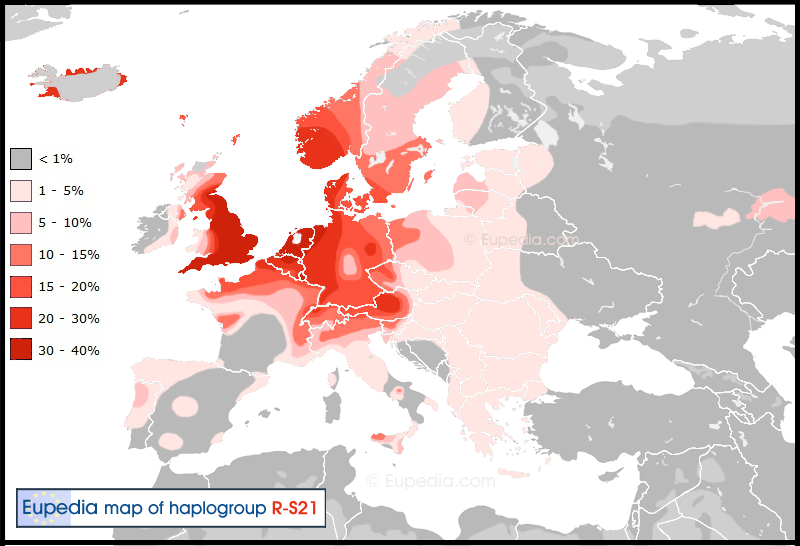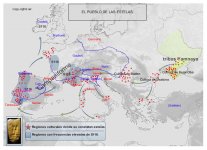Why is it impossible? Is it not classical? when we had to compare all marginal element with the Gauls? When the concepts about what is or not celtic never has been clears and we called the no standard gaulish elements with terms like ligurians, alteuropäisch, pre-celtic, that is to say nothing exactly? .
Actually, I would argue that you are
ad-hoc deciding 'what is or what is not Celtic has never been clear defined' with (from my perspective) no sensible reason (other than that you somehow want to 'prove' that Gauls are 'impure Indo-Europeans'), because it very much is clear-defined. I'm not talking about Gaulish alone. I'm also taking the the Goidelic (Irish, Scottish Gaelic, Manx Gaelic - but also including Oghamic Irish and Old Irish) and Brythonic (Cornish, Breton, Welsh) languages into account here. The Neogrammarian hypothesis states that sound laws
have no exceptions and when they
seemingly have exceptions, these are governed by their own set of rules (compare for example Verner's Law). Using the comparative method, it is possible to establish common Celtic sound laws.
To demonstrate this, let me take actually the example of the Goidelic languages alone in their relationship to other languages. Let us play dumb for a moment and completely unaware of the exact relationship between the languages, and let me take a few words:
'anger', 'rage' - Irish and Scottish Gaelic '
Fearg',
'alder' - Irish 'Fhearnóg', Scottish Gaelic '
Feàrna', Old Irish '
Fern'
'man' - Irish and Scottish Gaelic '
Fear', Old Irish '
Fer'
'fair', 'white' - Irish, Scottish Gaelic '
Fionn', Old Irish '
Finn'
Now, we can compare these three terms with words in other Celtic languages, and other Indo-European languages:
- the Gaulish term '
Vergobretos'
- the Gaulish tribal name 'Ar
verni', the ancient British town name 'Duro
vernum', the Breton and Welsh words for alder, '
Gwern'
- the Gaulish tribal name '
Viromandui', Welsh
Gŵr ('husband'), Latin '
Vir'
- town names '
Vindobonna', '
Vindelia', '
Vindia' etc., tribal name '
Vindelici', Welsh '
Gwyn'
From that, we can establish that there is a sound correspondence of Goidelic *f- to *w- in Gaulish and *gw- in (modern) Brythonic. We can also establish that *w- is very likely to be the original state in the Celtic languages because it's also *w- in a non-Celtic language (Latin). If we had absolutely no knowledge about the exact relationship of Gaulish, Welsh, Breton and Latin to the Goidelic languages, we could still argue that that *w was the original state, and that there was a shift to *gw in Brythonic and *f in Goidelic. Therefore, if we define the Goidelic languages by *w > *f, it would be perfectly logical to refer to Gaulish and Latin as 'Pre-Goidelic' and perhaps to Breton and Welsh as 'Para-Goidelic'. One would, of course, not use just one sound law to define a language family, but bear in mind that this was just a thought experiment to visualize the concept of sound correspondence. Let's now assume, for some strange reason, the Irish had adopted the Welsh word for 'alder' (Gwern), we could (correctly!) determine that the word is of non-Goidelic origin because it does not correspond with Goidelic sound laws. As a result, statements like "Goidelic sound laws absolutely are invalid, because *w-, *f- and *gw- can be in free variation!" or "town names like Vindelia, Vindia and Vindobonna are evidence of deeply ancient Goidelicity!" (to apply some of your arguments on this) are absolutely untenable.
Now, imagine that the same procedure can be applied with Ligurian elements in southeastern Gaul and Para-Celtic elements in western Hispania, respectively. In regard for the latter, it should be pointed out that the loss of *p at initial and intervocalic positions is a development that is very much attested in Celtiberian ('uper-' > 'uer-', 'pro-' > 'ro-') and Gallaecian (Tout
atis). The treatment of certain consonant clusters with *p (*-pl-)
is debatable, and it's conceivable that *p was preserved in consonant clusters in Proto-Celtic and that the common treatment that we see in Goidelic, Gaulish and Brythonic is a later innovation. On the flip side, the treatment of these consonant clusters suggests that the loss of *p was indeed not an abrupt 'event' but the result of a chain of developments that was successively executed by Proto-Celtic. In any case, the loss of initial and intervocalic *p- (as opposed to in clusters!) is something that is undeniably attested in Celtiberian and Gallaecian, and this suggests that the occurrences of *p- in the Celtic context in Hispania are not Celtic in origin, and that this is evidence for a Pre-Celtic (or Para-Celtic) substrate in western Hispania. If you want to argue that these are Celtic
anyways, this requires you to redefine the Celtic languages and you have to demonstrate that these Para-Celtic elements share innovations with the (proper) Celtic languages. This, by the way, something for which I have not seen a single piece of convincing evidence yet. Also, this
still requires that the other Celtic languages (Goidelic, Brythonic, Gaulish, Celtiberian) are all closer related with each other due to the fact that they share innovations not found in these name elements Western Hispania.
What I am suggesting instead is that these Para-Celtic elements in Western Hispania represent a wave of Indo-Europeans that was either earlier or simultaneous to the Celtization of the British Isles and Armorica, and that the
actual Celtization of northern and western Hispania took place via trade contact inside the Atlantic Bronze Age.
EDIT: I'm going to attach the map again to visualize the problem: if the Stelae People hypothesis was correct
in any way, then we would probably expect the Iberian penninsula to be the most Indo-Europeanized area in Western Europe in Antiquity. Instead, we find three non-IE languages in the area (Basque, Iberian, Tartessian), and it is clear that other areas of Europe were far more Indo-Europeanized and also Celticized than Iberia. Indeed, the British Isles were in Antiquity probably the most Celticized region in Europe, due to the complete absence of non-Celtic languages. We also find not-IE terms for metals and metal-working in the Basque language, which suggests the existence of a non-Indo-European spread of metalworking in Western Europe, and in my opinion the Beaker-Bell Culture remains the most plausible candidate for such a spread of non-IE metalworking.
Unrelated of that, there is also another genetic-based objection for the identity of the Beaker-Bell Culture as carriers of R1b: if R1b-P312/S116 entered Europe via the Southwest, how can we explain that the closest related outgroup (R1b-U106/S21) is found in Central and Northern Europe?
We would also expect R1b-L11* to be found in higher concentrations in the Southwest of the Iberian penninsula.



